|

The South Atlantic Anomaly
by Mori
November 7, 2007
from
Forgetomori Website
The map above does not represent the most common destination for
fleeing Hollywood villains.
It’s in fact the South Atlantic Anomaly,
a region where the Earth’s inner van Allen radiation belt makes its
closest approach to the planet’s surface. The result is that, for a
given altitude, the radiation intensity is higher over this region
than elsewhere.
Brazilians are blessed indeed.
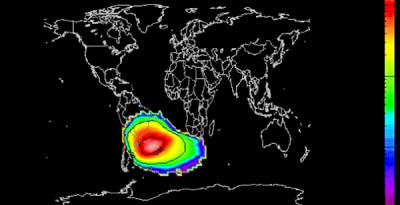
The Anomaly in the radiation belt
results from the fact that the planet’s magnetic field is not
perfectly aligned with its geographic center and poles.
Which means
the magnetic field is slightly stronger in the North, and moves
around the geographic poles, leaving the area around Brazil and the
South Atlantic closer to the radiation belts.
Fortunately, the effects of it over humans on the surface of the
planet are not significant. Unfortunately, it’s very relevant to
orbiting satellites - the Hubble Space telescope does not take
observations while passing through the South Atlantic Anomaly, for
instance.
Satellite failures are much more common in this stronger
radiation zone.
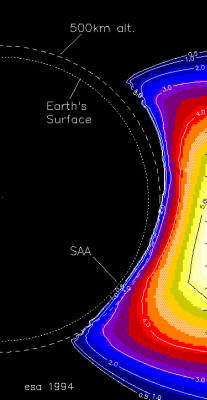
It also affects satellites with humans inside, like the
International Space Station. Light Flashes, thought to be produced
by radiation directly stimulating the retina of astronauts, are
reportedly more common when they are flying through the zone.
As the Anomaly is due to the Earth’s magnetic field, and since it’s
always moving - including several complete reversals - it probably
danced around the planet for the past billion years. It’s curious
indeed that such a “special area” would even exist.
And right now,
it’s Brazilian.
Researchers build magnetic observatory in the middle of the Atlantic
Ocean
by Science Centric
25 November 2008
from
Sciencecentric Website
A new Danish observatory on a remote island in the middle of the
Atlantic Ocean will provide researchers with new knowledge about the
mysterious irregularity of the Earth's magnetic field known as the
South Atlantic Anomaly.
The observatory is a partnership between DMI,
the Danish Meteorological Institute, and DTU Space, the Danish
National Space Institute.
The new geomagnetic observatory is located on the island of
Tristan da Cunha and was
inaugurated on Friday 14 November by the island's roughly 300
inhabitants and a few of the researchers on the project.
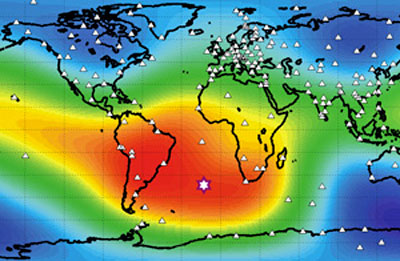
Tristan da Cunha is
located right in the middle of the South Atlantic Anomaly,
which is the area
where the Earth's magnetic field is weakest.
Danish National Space
Centre
Tristan da Cunha is the remotest inhabited island in the world and
is also located right in the middle of the South Atlantic Anomaly,
which is the area where the Earth's magnetic field is weakest.
This
makes it incredibly interesting for the Danish researchers, who are
working to understand the Earth's magnetic field and the way in
which it affects satellites, for example.
'Until now, Denmark has mostly been involved in projects that
measure the magnetic field from space, with the Orsted satellite and
the future Swarm satellite mission, as well as the measuring
stations in Greenland,' says Professor Nils Olsen of DTU Space.
'With the observatory on Tristan da Cunha, we will have a measuring
station in the Tropics right in the middle of the South Atlantic
Anomaly, where the strength of the magnetic field is only half as
high as in Denmark.'
At present the strength of the Earth's magnetic field is decreasing
by 5% every hundred years and researchers do not know why or what
the consequences will be.
In the South Atlantic Anomaly, the
strength of the magnetic field is decreasing ten times as fast and
the measuring station will therefore also give the researchers the
opportunity to learn more about the consequences of the global
weakening of the magnetic field.
The magnetic field protects the Earth from radiation from space and
the area around the South Atlantic Anomaly is therefore very poorly
protected. In the Anomaly, the radiation belts that surround the
Earth, the van Allen belts, are very close to the surface of the
Earth.
This is, among other things, significant to satellites, which
suffer by far the majority of faults when they fly through this
area.
'Opening the observatory is a milestone in our research,' says
senior researcher Juergen Matzka from DMI, who is heading the
project.
'Finding a suitable location for the cabin on the island
was a major logistical challenge, and we had a lot of help from
South African colleagues and the French firm of engineers EnviroConsult. The cabin is also built exclusively of wood and brass
in order not to disturb the magnetic measurements.'
Shipping
instruments to the island is no mean feat, as Tristan da Cunha is
six days' sailing from Cape Town, and there is no port or airport on
the island.
Air France 447 electrical problems and the South Atlantic Anomaly
by Tony Pann
Baltimore Weather Examiner
June 4, 2009
from
Examiner Website
The
Bermuda Triangle and missing aircraft may seem like science
fiction, but there is a well documented region off of the coast of
Brazil that contains highly charged particles.
This area is known as
the South Atlantic Anomaly and is avoided at all costs by orbiting
satellites. NASA satellites that do travel in the region are shut
down, or go into SAFE mode to avoid damage while passing over the
Atlantic between Brazil and Africa.
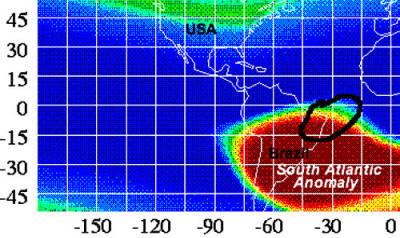
ROSAT image of South
Atlantic Anomaly.
Air France 447 flight
path circled in black.
The electrical field around earth protects us from cosmic rays.
There are two bands that trap highly charged particles circle the
earth. The protons trapped near the surface is in this region called
the Van Allen Belt. This radiation can cause all sorts of
malfunctions in spacecraft electronics. In fact, the Geiger counter
used to measure cosmic rays on Explorer 1 in 1958 stopped
functioning because it was overloaded by radiation!
So what is the connection to Air France flight 447? This is where
the highly technical science could put some to sleep.
While this
flight path is used by commercial pilots without incidence daily,
there is the possibility that one of these tropical thunderstorms
tapped into the electric field nearby. The Inter Tropical
Convergence Zone is know for some of the most violent thunderstorms
on the planet.
With cloud tops over 50,000 feet and violent updrafts
of 100 mph, there was a tremendous amount of electricity generated.
My friend, a commercial pilot, tells me that lightning can be
constant in these storms.
So I pose this question for the flight
experts and astrophysicists:
Could flight 447 have been affected by
a rare sequence of events including a direct lightning strike,
extreme proton charge from the South Atlantic Anomaly, and then left
defenseless as the storm and G-Forces in the violent up and
downdrafts tore the fuselage apart?
For more see below images:
|
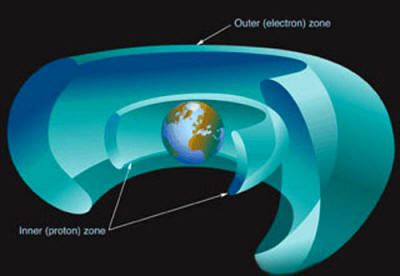 |
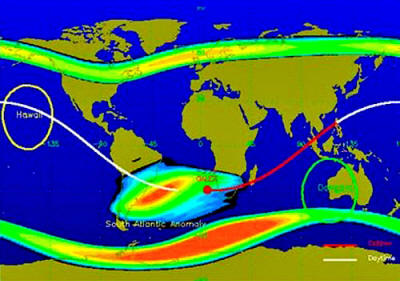 |
|
Although most of our scientific equipment is pointed
towards the sky (satellites, telescopes etc,) to measure
the Suns activity and its effect on our magnetic field,
ionosphere, stratosphere, and as of late our weather
(see equation): Equation: Sunspots => Solar Flares =>
Magnetic Field Shift => Shifting Ocean and Jet Stream
Currents => Extreme Weather and Human Disruption
|
Ground trace of a single GALEX orbit. The particle flux
associated with the SAA is modeled (blue = low to
red=high). The red line is the night side of the orbit,
the day side is white. The high voltage supply on the
detectors are not ramped until after exiting the SAA.
The viewing cones of the two ground stations are also
displayed. A contact with the Hawaii station is possible
on this orbit. |
|
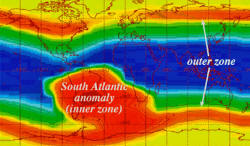
|
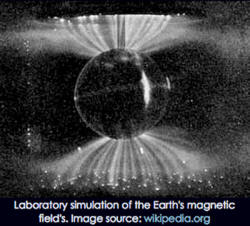 |
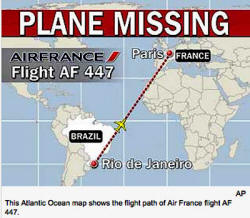 |
|
Count rate of protons and electrons greater than 0.5 MeV
in low Earth orbit measured by the NASA/SAMPEX
satellite.
|
Most of the proton belt is about 12001300 kilometers
high, but it dips down as low as 200300 kilometers off
the lower coast of Brazil, creating a phenomenon known
as the South Atlantic Anomaly. At certain altitudes, the
South Atlantic Anomaly is bigger than Brazil itself.
|
Did
Air France Flight 447 travel on the edge of the South
Atlantic Anomaly and get a rare impact on their
electrical systems from a violent thunderstorm?
|
Lightning blamed for missing Air France Flight 447
Initial search for Air France Flight 447
An article by Rich Battros from 2005 in
redicecreations.com asked
the question about whether airlines have been notified?
He cites the
following incidents as a result of the Van Allen Belts:
United Airlines reported high frequency (HF) communications losses
and solar radiation storms which caused planes to be diverted to
less dangerous routes. Rerouting and general delays are costly to
the airlines. One example of that was a storm that caused a flight
to be diverted from a polar route, requiring additional fuel at
Tokyo and extending the flight by 5 hrs 30 min.
During another period, 25 flights were flown on less than optimal
polar routes due to HF communications problems. Northwest Airlines
diverted a Detroit-Beijing flight to a non-polar route due to both HF communications problems (radio blackout) and a solar radiation
storm, forcing an unscheduled stop at Fairbanks for fuel.
This route
change resulted in an approximately 3 hour delay and $100,000 cost
to NWA, plus the inconvenience and loss attendants upon disrupting
the travel of passengers.
The Director of Flight Operations of Continental Airlines reported
that they diverted their daily flight for the second day in
succession based on the S3 level of solar radiation storm.
The
direct impact was 2 hours of extra flight time and additional
associated costs.
South Atlantic Anomaly and South Georgia Magnetic Observatory
from
BGS Website
Why is BGS re-establishing a magnetic observatory on South Georgia?
The South Georgia observatory will plug a significant gap in the
global network of magnetic observatories.
In particular South
Georgia observatory will allow better monitoring of the South
Atlantic Anomaly and of changes occurring deep within the Earth. By
establishing the new observatory, BGS will re-start continuous
magnetic observations in South Georgia, last carried out in 1982.
What is the South Atlantic Anomaly?
The Earth’s magnetic field, generated deep within the planet, is a
shield against particle radiation from space.
In the South Atlantic
this shield is much weaker than elsewhere across the globe and
radiation from space therefore penetrates deeper into the
atmosphere. This region is known as the South Atlantic Anomaly (SAA)
and the radiation in the SAA is a known hazard to satellites,
spacecraft and high-altitude aircraft.
Monitoring changes in magnetic field
The radiation input into the atmosphere depends on the Sun’s
magnetic and radiation activity and the geometry (or ‘shape’) of the
Earth’s magnetic field. So, understanding the space environment,
particularly during magnetic storms, is important.
Equally important
is understanding any changes over time in the magnetic field
observed across the surface of the Earth - see also Long-term
monitoring of the Earth’s magnetic field.
A magnetic reversal in progress?
The South Atlantic Anomaly (SAA) is known to be growing in extent
and spreading westwards from South Africa, as the Earth’s internal
magnetic field rapidly weakens in this region.
This may be early
evidence of a forthcoming reversal in the direction of the Earth’s
internal magnetic field. We do not know in detail precisely what
occurs during such reversals, including the changes observed in the
magnetic field and the time a reversal takes to complete. However
these factors are important in knowing where the radiation risk may
be increased and how the atmosphere might respond.
Earth’s magnetic field has had many highs, lows and reversals in its
past. The last reversal was around 800,000 years ago. So the Earth
is known to be able to re-generate its field and has done so during
human pre-history.
Understanding the development of the SAA may
therefore be significant in understanding the reversal process and
its impact on life and the natural environment.
New South Georgia Magnetic Observatory
By establishing a magnetic observatory on South Georgia BGS
geomagnetists will specifically help to develop our understanding of
the SAA by:
Joined up monitoring
Directly observing changes in the SAA in a region (mid Atlantic
Ocean) poorly covered by permanent magnetic observatories. In the
middle of the ocean only Ascension Island, Tristan da Cunha and St
Helena observatories can provide monitoring of the magnetic field
and its changes. We need to better relate observations of the SAA
made separately on the land masses of Africa and South America.
South Georgia observatory will therefore be a key addition to this
small network of observatories.
Improving predictions
Providing new data to construct better mathematical models of the
magnetic field.
Such models can be used to infer how the flow of
liquid iron in the outer core of the Earth is changing. This fluid
flow sustains our magnetic field and forecasting how it changes in
time will help improve predictions of future change in the SAA.
Understanding the complete ‘Earth System’
Promoting collaboration between space scientists, concerned with
Earth’s space environment, and geoscientists, concerned with Earth’s
other environments.
There are major communities of these researchers
both in the UK and internationally and the expertise of both space-
and geo-scientists are needed to fully understand the complete
‘Earth system’.
Measuring, monitoring and modeling the Earth’s
magnetic field is a key aspect of this understanding and that is
BGS’ contribution to this Endeavour.

Image
comprising a series of pictures stitched to show Myviken Bay
looking along
the Bore Valley from the North,
South Georgia.
British
Antarctic Survey © NERC
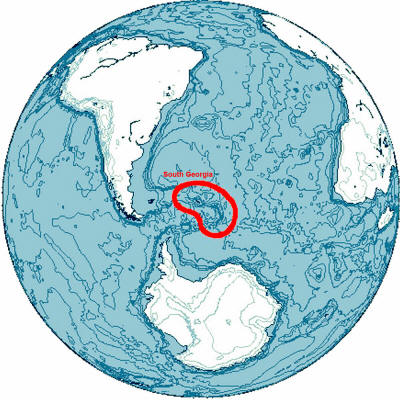
South Georgia
2011 Earthquakes Mid
Atlantic Ridge
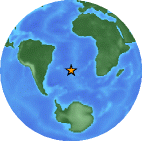
Earthquakes 2010-2011 Mid Atlantic Ridge:
-
Rectangular Grid Search
-
Latitude Range: -70 to 10
-
Longitude Range: -80 to 40
-
Number of Earthquakes: 532
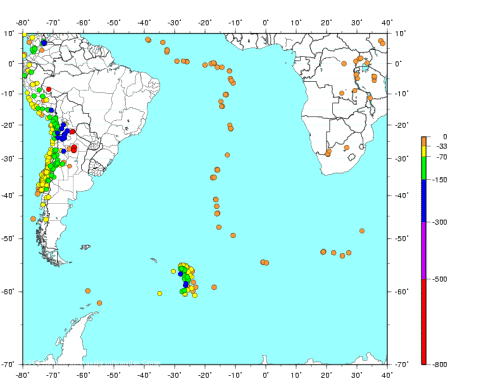
Earthquakes 2010 Mid Atlantic Ridge:

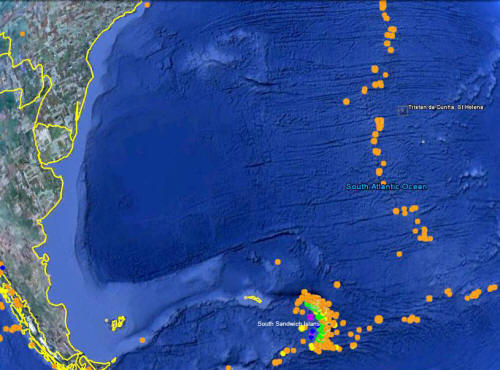
Earthquakes 2009 Mid Atlantic Ridge:
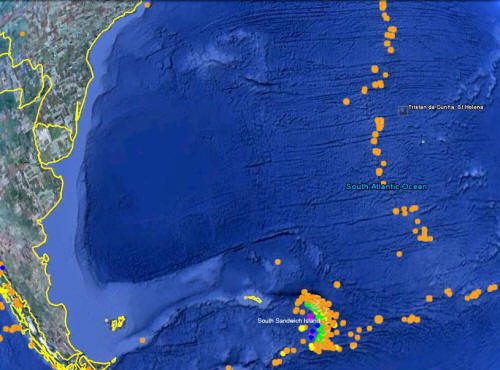
|
















